Small overlap front: driver-side
Rating applies to 2012-19 models
Tested vehicle: 2014 Nissan Versa S 4-door
The Nissan Versa sedan was redesigned for the 2012 model year, but the Versa hatchback was not redesigned and remained essentially unchanged for the 2012 model year. Therefore the small overlap frontal ratings detailed below apply only to the sedan. Also, the sedan's weight was reduced sufficiently to reclassify it as a minicar beginning with the 2012 redesign. (Earlier sedans and the 2007-12 hatchbacks are classified as small cars.)
Following a one-year absence, the Versa hatchback was redesigned for the 2014 model year and renamed the Versa Note. Nissan believes the Versa Note is sufficiently different from the Versa sedan that the two variants do not share ratings.
| Evaluation criteria | Rating |
|---|---|
| Structure and safety cage | |
| Driver injury measures | |
| Head/neck | |
| Chest | |
| Hip/thigh | |
| Lower leg/foot | |
| Driver restraints and dummy kinematics The dummy’s head barely contacted the frontal airbag before sliding off the left side and leaving the head vulnerable to contact with forward structure. The steering column moved upward 12 cm and 15 cm to the right, contributing to a lack of protection for the head and allowing little airbag cushioning for the chest. The side curtain airbag deployed and had sufficient forward coverage to protect the head from contact with forward side structure and outside objects. The side torso airbag also deployed. (Beginning with 2016 models, the driver frontal airbag was changed to a simpler design with flexible venting technology. Because the dummy's head barely interacted with the frontal airbag in the test of the 2014 model, it is unlikely that any changes in dummy kinematics would be expected in 2016 and later models.) | |

Action shot taken during the small overlap frontal crash test.
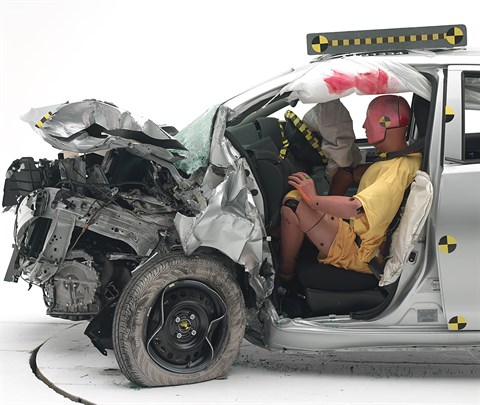
The dummy's position in relation to the door frame, steering wheel, and instrument panel after the crash test indicates that the driver's survival space was not maintained well.

During the crash, the dummy's head and torso barely contacted the airbag before sliding off to the left as the steering column moved upward and to the right. The side curtain airbag extended far enough forward toward the A-pillar to protect the head from contact with forward side structure.
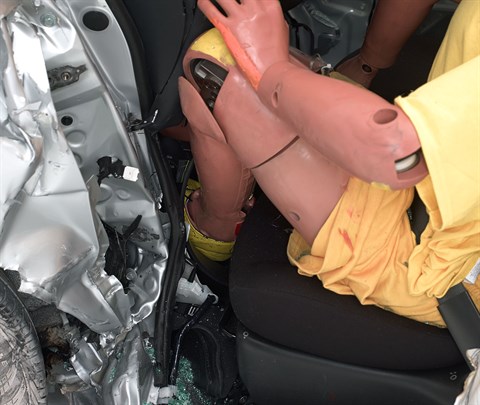
Door hinge pillar and instrument panel intrusion was extensive and contributed to a high risk of injury to the left lower leg and a moderate risk to the left knee.
Moderate overlap front: original test
Rating applies to 2012-15 models
Tested vehicle: 2012 Nissan Versa 1.6 S 4-door
The Nissan Versa sedan was redesigned for the 2012 model year, but the Versa hatchback was not redesigned and remained essentially unchanged for the 2012 model year. Therefore the moderate overlap frontal ratings detailed below apply only to the sedan. Also, the sedan's weight was reduced sufficiently to reclassify it as a minicar beginning with the 2012 redesign. (Earlier sedans and the 2007-12 hatchbacks are classified as small cars.) Moderate overlap frontal ratings are assigned by the Institute based on a test conducted by Nissan.
Following a one-year absence from the market, the Versa hatchback was redesigned for the 2014 model year and renamed the Versa Note. Nissan believes the Versa Note is sufficiently different from the Versa sedan that the two variants do not share ratings.
| Evaluation criteria | Rating |
|---|---|
| Overall evaluation | |
| Structure and safety cage | |
| Driver injury measures | |
| Head/neck | |
| Chest | |
| Leg/foot, left | |
| Leg/foot, right | |
| Driver restraints and dummy kinematics | |
Side: original test
Rating applies to 2012-15 models
Tested vehicle: 2012 Nissan Versa 1.6 SV 4-door with standard front and rear head curtain airbags and standard front seat-mounted torso airbags
The Nissan Versa sedan was redesigned for the 2012 model year, but the Versa hatchback was not redesigned and remained essentially unchanged for the 2012 model year. Therefore the side ratings detailed below apply only to the sedan. Also, the sedan's weight was reduced sufficiently to reclassify it as a minicar beginning with the 2012 redesign. (Earlier sedans and the 2007-12 hatchbacks are classified as small cars.)
Following a one-year absence from the market, the Versa hatchback was redesigned for the 2014 model year and renamed the Versa Note. Nissan believes the Versa Note is sufficiently different from the Versa sedan that the two variants do not share ratings.
| Evaluation criteria | Rating |
|---|---|
| Overall evaluation | |
| Structure and safety cage | |
| Driver injury measures | |
| Head/neck | |
| Torso | |
| Pelvis/leg | |
| Driver head protection | |
| Rear passenger injury measures | |
| Head/neck | |
| Torso | |
| Pelvis/leg | |
| Rear passenger head protection | |
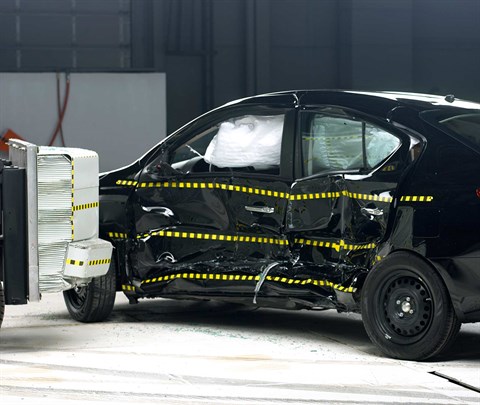
View of the vehicle and barrier just after the crash test.
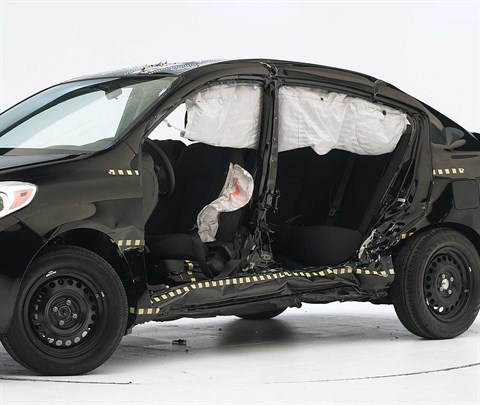
View of the vehicle after the crash with doors removed, showing the side airbags and damage to the occupant compartment.
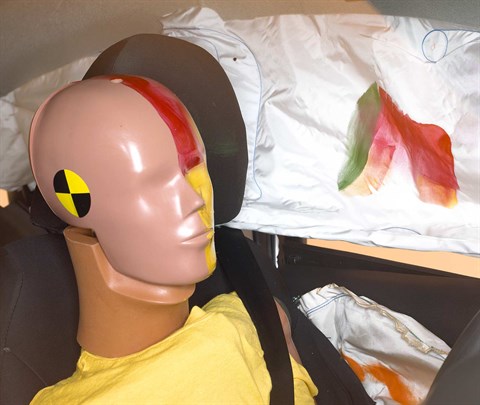
Smeared greasepaint shows where the driver dummy's head was protected from being hit by hard structures by the side curtain airbag.
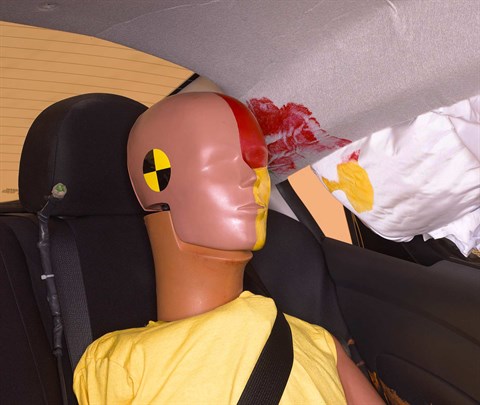
Smeared greasepaint shows where the rear passenger dummy’s head was protected by the side airbag.
Roof strength
Rating applies to 2012-19 models
Tested vehicle: 2012 Nissan Versa 1.6 S 4-door
| Overall evaluation | |
|---|---|
| Curb weight | 2,412 lbs |
| Peak force | 11,947 lbs |
| Strength-to-weight ratio | 4.95 |
Head restraints & seats
Seat type: Manual cloth seat with fixed head restraint
| Overall evaluation | |
|---|---|
| Dynamic rating | |
| Seat/head restraint geometry |
Seat type: Manual cloth seat with adjustable head restraint
| Overall evaluation | |
|---|---|
| Dynamic rating | |
| Seat/head restraint geometry |
About the head restraint & seat test
Currently, IIHS tests apply only to front seats.
